The concept of merging swaths of grass using belts has been around for years. This method is most commonly used on trailed and butterfly mower units grouping swaths of grass. However, until now, the go-to tool to group grass after mowing has been the rake.
Larger trailed mergers have been on the market for some time, mainly used to carefully lift and move delicate Lucerne crops such as alfalfa. There was never a demand for mergers in the grouping of grass until recent times. Narrower working widths and higher buying costs over rakes are the main reasons why mergers never took off in Ireland for grass. Having said that, smaller front-mounted 3m mergers have become more common in recent years for the turning of straw given their delicate handling abilities.
So, what’s the difference between a rake and a merger? The difference is that a merger lifts the crop on to a belt conveyor which moves and deposits the swath into the desired location. Most mergers can deposit the crop to the left or the right by alternating the direction of the hydraulically driven belt conveyor. This means that the crop is never dragged along the ground, helping to reduce contamination.
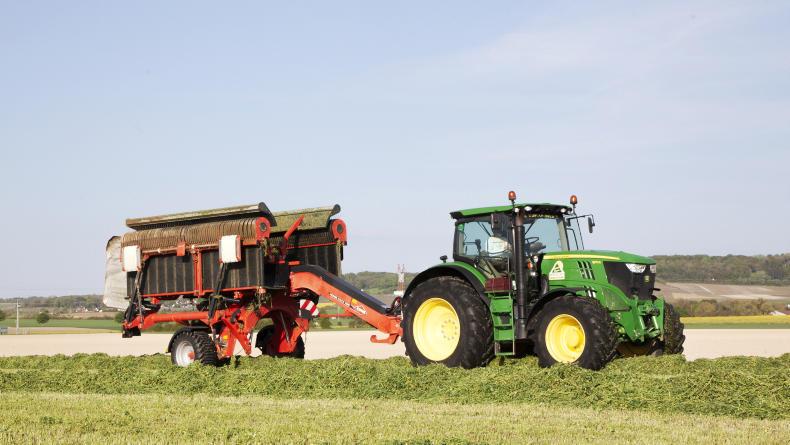
Last year Kuhn launched two new models , the Merge Maxx 780 and 1090.
Advantages
The main driving forces in Ireland for trailed belt mergers are both the contractor and the farmer. Stones are the main reason, from a contractor’s perspective, reducing the possibility of damage to the forager’s internals. Better presentation of the swath to the forager’s header is another factor which makes a notable difference in its ability to lift and chop the grass more efficiently. It is more apparent where contractors are using four rotor rakes. This is mainly down to the reduced handling of the grass, leaving it lying more uniform and not as “lumpy” and uneven as rakes often do. From a farmer’s perspective, the merger will help reduce contaminants in the grass before ensiling.
One of the biggest contaminant farmers find in silage is soil, which we know can lock up essential nutrients such as copper. If a merger reduces contamination, will farmers push their contractors into buying one?
What merger options are available?
Manufacturers of mergers offer similar variations of the concept. Most have a single front-mounted merger which can place the crop either to the left or the right of the tractor. Meanwhile, depending on the width, the trailed double merger has the ability to pick up a number of swaths and place them on an adjacent swath. The operator can then drive down on the other side of the merged swaths and place the same number of swaths on the grouped swath. Some double mergers offer the ability to merge two swaths into the centre, on top of an existing swath, similar to the way in which a twin-rotor rake operates.
Some manufacturers offer a combination of a front-mounted single merger and a trailed double-merger.
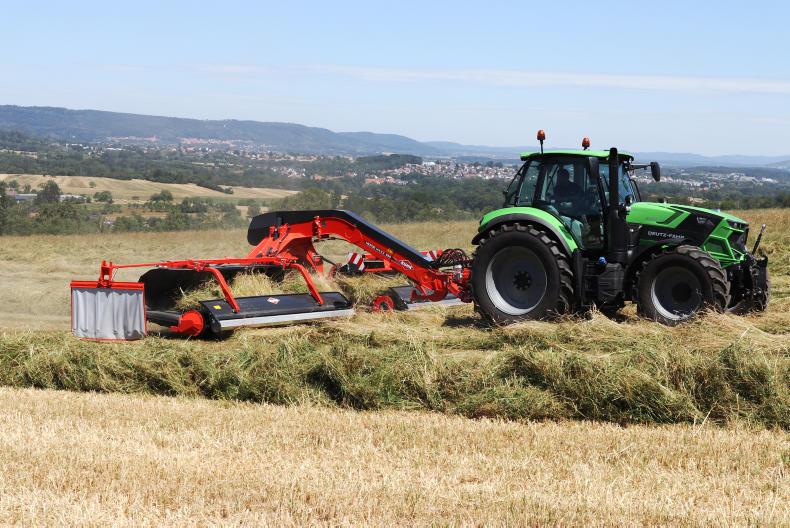
The way in which mergers handle grass helps reduce stone and soil contamination.
Manufacturers
Belt mergers are only produced by a handful of machinery manufacturers worldwide, but the growing interest has led such firms to respond and further develop their machines.
In Ireland, the brands leading the way in mergers are Kuhn and SIP, while ROC also has a presence.
Other firms such as Reiter and Ploeger are not yet officially in the country, but are big names in the business across mainland Europe.
The Irish Farmers Journal understands that Polish grass equipment manufacturer SaMASZ is in the process of bringing a merger to market, with its first expected next year.
Ploeger launched the world’s first self-propelled belt merger last autumn at Agritechnica.
The machine is capable of merging 12m of grass in one pass. In 2019, Kuhn also launched two new models of trailed belt mergers, the Merge Maxx 760 and 1090, which have maximum working widths of 7.5m and 11m, respectively.
Our VIEWS
We feel that the ever-increasing horsepower and throughput capacity of modern forage harvesters will lead to more of an opening for the use of mergers in silage making in Ireland. The concept of a merger is great, but the cost is a different story. Mergers are expensive machines. To buy a new four-rotor 41ft (12.5m) rake, you’re talking somewhere in the region of €55,000 to 60,000, plus VAT, depending on the brand and spec.
Meanwhile, having spoken to one manufacturer, its trailed merger capable of gathering 32ft (9.5m) would set you back in the region of €75,000 to €80,000, plus VAT. Mergers have a smaller working width than four-rotor rakes, but can travel at much higher speeds, while arguably leaving a nicer swath behind.
No doubt it’s a very interesting subject. Our view is that there will be more mergers sold in Ireland over the coming years, but they won’t replace the rake – there will be a place in the market for both machines.
Jim Good, Co Cork: Kuhn Merge Maxx 950
After encountering his share of stone-related damage to foragers, Jim felt that the concept of merger could help to reduce downtime while offering a more professional service to his clients. Jim has a new Kuhn merger bought for the 2020 silage season. “Everyone likes the concept of a merger, but they are very expensive machines. I found that rakes are very slow. When you are under pressure and forced to drive them on, all you are doing is digging into the ground and further contaminating the crop. I wanted a machine that could gather grass quicker and do a better job. If the merger can work at a faster speed, I’m hoping to be able to merge from both directions into the one swath, putting together 50ft of grass. However, if it only proves as good as a twin-rotor rake, then it will be a very expensive machine. I’m not sure if it will work; time will tell. If it works in northwest Cork, it’ll work anywhere in the world,” laughed Jim.
Willie John Kehoe, Co Wexford: ROC 760
After a trip to Agritechnica in Germany, Willie John Kehoe decided to purchase an Italian-built Roc merger. Now entering its seventh season, he explained that he learnt the hard way that side delivery of heavy crops on headland corners doesn’t work in Ireland.
“The machine is well-fit for Irish conditions, but a side delivery merger will not produce a good swath on the headland corners. It throws far too much grass into the one point. For Irish conditions, a centre delivery machine is key. As a result, we rake all the headlands. We bought it to handle haylage and silage, and it does a good job. It has reduced contamination of the crop and the amount of stones in the swath. From a maintenance point of view, we’ve only had to replace bearings and very few tines. The swath it produces is all down to the operator. It’s vital you have a good driver; it’s not a machine you’d let any lad off on. You need to match forward speed to the crop and to the speed of the machine. On average, it works 20% faster than a rake.”
The concept of merging swaths of grass using belts has been around for years. This method is most commonly used on trailed and butterfly mower units grouping swaths of grass. However, until now, the go-to tool to group grass after mowing has been the rake.
Larger trailed mergers have been on the market for some time, mainly used to carefully lift and move delicate Lucerne crops such as alfalfa. There was never a demand for mergers in the grouping of grass until recent times. Narrower working widths and higher buying costs over rakes are the main reasons why mergers never took off in Ireland for grass. Having said that, smaller front-mounted 3m mergers have become more common in recent years for the turning of straw given their delicate handling abilities.
So, what’s the difference between a rake and a merger? The difference is that a merger lifts the crop on to a belt conveyor which moves and deposits the swath into the desired location. Most mergers can deposit the crop to the left or the right by alternating the direction of the hydraulically driven belt conveyor. This means that the crop is never dragged along the ground, helping to reduce contamination.

Last year Kuhn launched two new models , the Merge Maxx 780 and 1090.
Advantages
The main driving forces in Ireland for trailed belt mergers are both the contractor and the farmer. Stones are the main reason, from a contractor’s perspective, reducing the possibility of damage to the forager’s internals. Better presentation of the swath to the forager’s header is another factor which makes a notable difference in its ability to lift and chop the grass more efficiently. It is more apparent where contractors are using four rotor rakes. This is mainly down to the reduced handling of the grass, leaving it lying more uniform and not as “lumpy” and uneven as rakes often do. From a farmer’s perspective, the merger will help reduce contaminants in the grass before ensiling.
One of the biggest contaminant farmers find in silage is soil, which we know can lock up essential nutrients such as copper. If a merger reduces contamination, will farmers push their contractors into buying one?
What merger options are available?
Manufacturers of mergers offer similar variations of the concept. Most have a single front-mounted merger which can place the crop either to the left or the right of the tractor. Meanwhile, depending on the width, the trailed double merger has the ability to pick up a number of swaths and place them on an adjacent swath. The operator can then drive down on the other side of the merged swaths and place the same number of swaths on the grouped swath. Some double mergers offer the ability to merge two swaths into the centre, on top of an existing swath, similar to the way in which a twin-rotor rake operates.
Some manufacturers offer a combination of a front-mounted single merger and a trailed double-merger.

The way in which mergers handle grass helps reduce stone and soil contamination.
Manufacturers
Belt mergers are only produced by a handful of machinery manufacturers worldwide, but the growing interest has led such firms to respond and further develop their machines.
In Ireland, the brands leading the way in mergers are Kuhn and SIP, while ROC also has a presence.
Other firms such as Reiter and Ploeger are not yet officially in the country, but are big names in the business across mainland Europe.
The Irish Farmers Journal understands that Polish grass equipment manufacturer SaMASZ is in the process of bringing a merger to market, with its first expected next year.
Ploeger launched the world’s first self-propelled belt merger last autumn at Agritechnica.
The machine is capable of merging 12m of grass in one pass. In 2019, Kuhn also launched two new models of trailed belt mergers, the Merge Maxx 760 and 1090, which have maximum working widths of 7.5m and 11m, respectively.
Our VIEWS
We feel that the ever-increasing horsepower and throughput capacity of modern forage harvesters will lead to more of an opening for the use of mergers in silage making in Ireland. The concept of a merger is great, but the cost is a different story. Mergers are expensive machines. To buy a new four-rotor 41ft (12.5m) rake, you’re talking somewhere in the region of €55,000 to 60,000, plus VAT, depending on the brand and spec.
Meanwhile, having spoken to one manufacturer, its trailed merger capable of gathering 32ft (9.5m) would set you back in the region of €75,000 to €80,000, plus VAT. Mergers have a smaller working width than four-rotor rakes, but can travel at much higher speeds, while arguably leaving a nicer swath behind.
No doubt it’s a very interesting subject. Our view is that there will be more mergers sold in Ireland over the coming years, but they won’t replace the rake – there will be a place in the market for both machines.
Jim Good, Co Cork: Kuhn Merge Maxx 950
After encountering his share of stone-related damage to foragers, Jim felt that the concept of merger could help to reduce downtime while offering a more professional service to his clients. Jim has a new Kuhn merger bought for the 2020 silage season. “Everyone likes the concept of a merger, but they are very expensive machines. I found that rakes are very slow. When you are under pressure and forced to drive them on, all you are doing is digging into the ground and further contaminating the crop. I wanted a machine that could gather grass quicker and do a better job. If the merger can work at a faster speed, I’m hoping to be able to merge from both directions into the one swath, putting together 50ft of grass. However, if it only proves as good as a twin-rotor rake, then it will be a very expensive machine. I’m not sure if it will work; time will tell. If it works in northwest Cork, it’ll work anywhere in the world,” laughed Jim.
Willie John Kehoe, Co Wexford: ROC 760
After a trip to Agritechnica in Germany, Willie John Kehoe decided to purchase an Italian-built Roc merger. Now entering its seventh season, he explained that he learnt the hard way that side delivery of heavy crops on headland corners doesn’t work in Ireland.
“The machine is well-fit for Irish conditions, but a side delivery merger will not produce a good swath on the headland corners. It throws far too much grass into the one point. For Irish conditions, a centre delivery machine is key. As a result, we rake all the headlands. We bought it to handle haylage and silage, and it does a good job. It has reduced contamination of the crop and the amount of stones in the swath. From a maintenance point of view, we’ve only had to replace bearings and very few tines. The swath it produces is all down to the operator. It’s vital you have a good driver; it’s not a machine you’d let any lad off on. You need to match forward speed to the crop and to the speed of the machine. On average, it works 20% faster than a rake.”





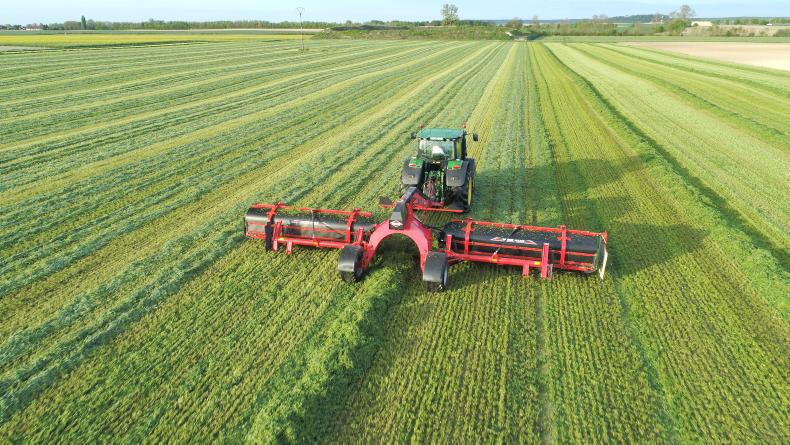

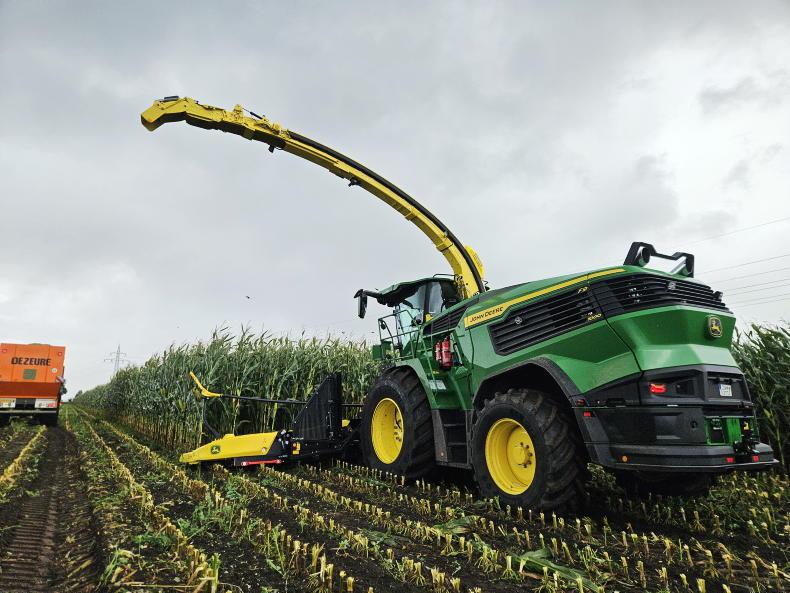

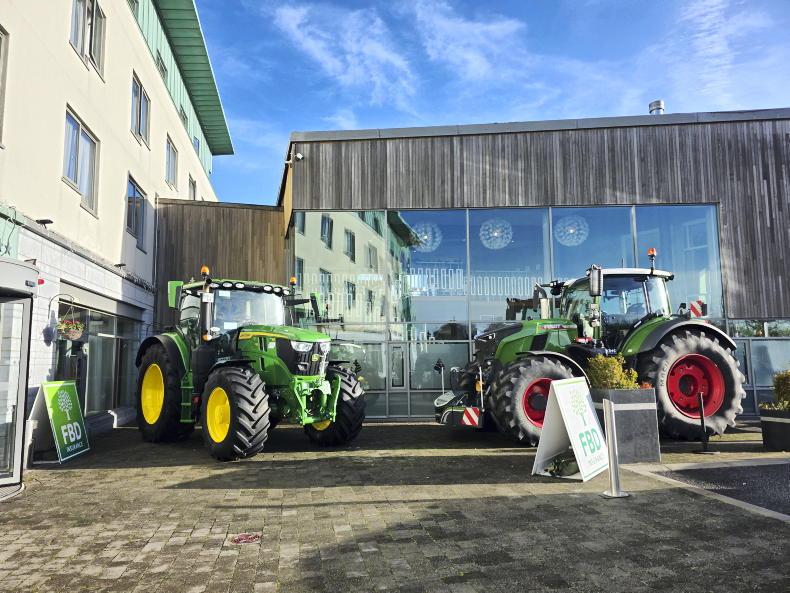
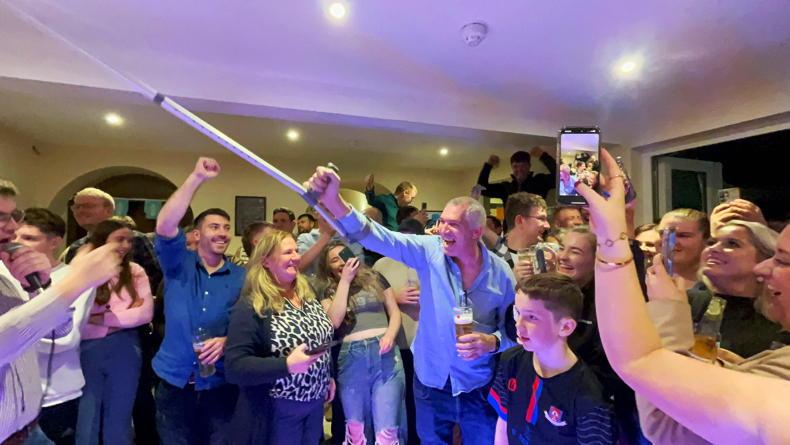

SHARING OPTIONS